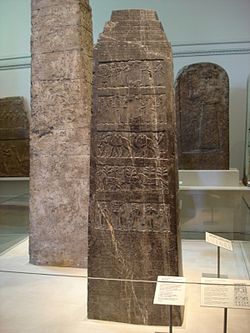Black obelisk

The Black Obelisk of Shalmaneser III. (ruled around 858 to 824 BC) is a New Assyrian black bas-relief limestone from Nimrud (Kalchu) in northern Iraq. It has a height of 197.85 cm and a width of 45.08 cm. It is currently on display in the British Museum .
Of the Assyrian obelisks discovered so far, it is the best preserved and is historically significant because of the earliest depiction of an Israelite . The obelisk was built in 825 BC. BC, in a time of civil war, erected as a public monument. In 1846 it was discovered by the archaeologist Sir Henry Layard .
The obelisk has 20 reliefs, five on each side. They represent five subjugated kings who offer tribute and prostrate themselves to the Assyrian king. From top to bottom these are:
- Sua, the maddattu of Gilzanu ( KUR gil-a-na-aa) in northwestern Iran
- Jehu from the house of Omri ( ia-ua DUMU hu-um-rii ), the ancient northern kingdom of Israel . According to some researchers, ia-ua should not be read as Jehu, but as Joram .
- the maddattu of Mušri ( ša mat mu-uš-ri ), Egypt?
- Marduk-apil-uṣur from Šuhi on the central Euphrates, Syria and Iraq
- Qalparunda from Patina (the area of Antakya / Turkey).
Each scene occupies four fields around the obelisk and contains an inscription in cuneiform above each .
The second register from the top contains the oldest surviving image of an Israelite: Jehu , King of Israel prostrating before the Assyrian king. The inscription describes how Jehu brings or sends his tribute, around the year 841 BC. Chr. Jehu broke Israel's alliance with the Phoenician city-states and Judah and became an Assyrian vassal. The caption above the illustration, written in Akkadian, can be translated as follows:
"Tribute from Jehu, son of Omri: I received from him silver, gold, a golden bowl, a golden vase with a painted bottom, golden cups, golden vessels, pewter, a scepter for the hand of the king and spears ( puašatu )."
At the top and bottom of the relief there is a long cuneiform inscription, which contains the annals of Shalmaneser III. records. It lists the annual campaigns of the king and his general up to the 31st year of reign. Some peculiarities suggest that the work was commissioned by the Commander-in-Chief Dajan-Aššur .
literature
- CC Smith: Jehu and the Black Obelisk of Shalmaneser III. In: Arthur L. Merrill, Thomas W. Overholt (Eds.): Scripture in History and Theology. Essays in Honor of J. Coert Rylaarsdam. Pickwick Press, Pittsburgh PA 1977, ISBN 0-915138-32-8 , pp. 71-105 ( Pittsburgh Theological Monograph Series 17).
- M. Weippert: Jau (a) mar Humri - Joram or Jehu of Israel? In: Vetus Testamentum (VT). 28, 1978, ISSN 0042-4935 , pp. 115f.
- O. Keel, C. Uehlinger: The Assyrian King Shalmaneser III. and Jehu of Israel on the Black Obelisk from Nimrud. In: Journal for Catholic Theology (ZKT). 116, 1994, ISSN 0044-2895 , pp. 399f.